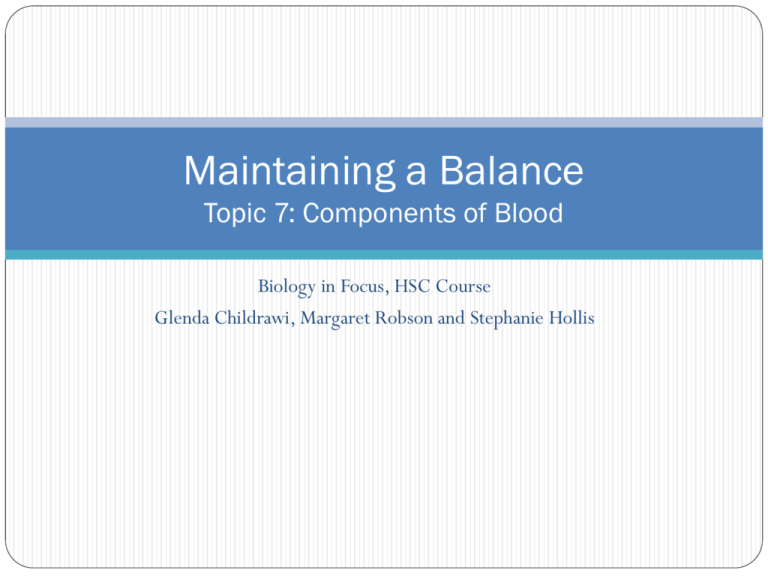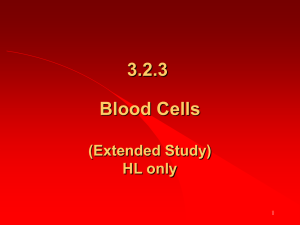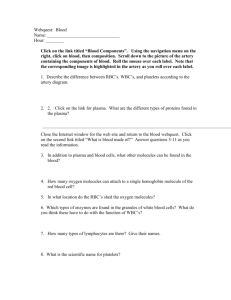Planet Earth and Its Environment A 5000
advertisement

Maintaining a Balance Topic 7: Components of Blood Biology in Focus, HSC Course Glenda Childrawi, Margaret Robson and Stephanie Hollis DOT POINT There is no DOT Point directly linked to this topic, however this topic will provide you with the background knowledge you need to know in order to understand the topics that follow. Introduction Both plants and animals require a transport system to distribute food and oxygen to active cells and to remove carbon dioxide and any other wastes products that may accumulate due to metabolic processes. allaboutwildlife.com Introduction Unicellular organisms and small multicellular organisms rely on the processes of diffusion, osmosis and active transport of substances directly between the surface of the organism and the environment. microscopy-uk.org.uk Introduction In most multicellular organisms, transport of substances in this way is not adequate, due to their large surface area to volume ratio. The distance that substances must move between the centre of the body of a large organism and its outer surface is to large to simply rely on diffusion, osmosis and active transport. dongettyphoto.com Introduction Therefore specialised transport systems have developed in complex plants and animals to carry substances. The common features of a transport system are: 1. A suitable transport medium (fluid) 2. The presence of vessels in which substances can be carried 3. A driving mechanism to ensure that substances move in the correct direction. extraordinarylight.blogspot.com Plants Plants produce their own food in leaves and this food must be carried in a dissolved form, to all parts of the plant. Chemical substances that are needed for photosynthesis must be carried from the roots, where they enter the plant to the leaves where they are used. The transport tissue in plants is known as vascular tissue and consists of xylem and phloem. commons.wikimedia.org Animals In animals, transport of chemicals occurs in a fluid medium such as blood and the same fluid circulates around the body. The role of the transport system is to pick up nutrients such as digested food and oxygen, and distribute them to parts of the body where they are needed. gumtree.com.au Animals Blood also picks up wastes such as carbon dioxide from the cells and carry them to excretory organs where they can be removed from the body. In mammals, the transport system is known as the cardiovascular system which is made up of the following: A pump (the heart) to move the blood in the correct direction A series of vessels (arteries and veins) that act like highways which direct the blood throughout the body. heraldsun.com.au Blood as a Medium Blood is a fluid transport medium that flows through the cardiovascular system in all vertebrates and some invertebrates. It is a complex fluid which consists of blood plasma and blood cells. gizmag.com Blood as a Medium If whole blood is spun in a centrifuge, it separates into its component parts: 45% cells and 55% watery plasma. At the bottom of the tube, the heavier cells settle out and appear dark red in colour due to the presence of red blood cells. The fluid part or plasma is lighter in colour (pale yellow) and contains many substances dissolved or suspended. sciencephoto.com Blood as a Medium Blood has a temperature of 38C and has a pH of 7.35. The volume of blood in the human body varies from one person to the next but an adult has approximately 5 litres of blood. For normal functioning of the body and its enzymes, these levels of temperature, pH and volume must be carefully maintained. scranton.edu The Composition of Blood Blood contains three main types of cells: 1. Red blood cells 2. White blood cells 3. Platelets All blood cells are produced in bone marrow lesleypaulvj.blogspot.com The Composition of Blood Red Blood Cells: There are approximately 4-6 million red blood cells per millilitre (mL) of blood and their main function is to transport oxygen. 1 mL is the amount of liquid that could fit into a cm cube. gcse.com The Composition of Blood Red Blood Cells: RBC’s form in bone marrow, at first each cells has a nucleus, but as the cell matures, the nucleus disappears and a red pigment called haemoglobin develops inside the cell. embryology.med.unsw.edu.au The Composition of Blood Red Blood Cells: As a result of the absence of a nucleus, the mature RBC’s are small, with a diameter of approximately 7μm (micrometers). RBC’s are round but they are biconcave rather than spherical. This picture is a scanning electron micrograph of a red blood cells. legacy.owensboro.kctcs.edu The Composition of Blood Red Blood Cells: RBC’s have a life span of about 4 months. When they die, they are broken down and replaced by newly formed blood cells from the bone marrow. fi.edu The Composition of Blood Red Blood Cells: Haemoglobin is an iron-containing protein molecule that gives red blood cells their colour. It consists of two parts: a protein (globin) and a pigmental iron compound called the haem group. hyperbaric-oxygen-info.com The Composition of Blood Red Blood Cells: Iron is therefore essential for the formation and maturation of red blood cells. Haemoglobin has an affinity for oxygen and readily combines with it to form oxyhaemoglobin. open.jorum.ac.uk The Composition of Blood Red Blood Cells: Haemoglobin releases oxygen easily in areas of low oxygen concentration. RBC’s are also about to transport a small amount of carbon dioxide in the blood and they help maintain the pH balance of the blood. cikgurozaini.blogspot.com The Composition of Blood White Blood Cells: White blood cells, also produce in bone marrow, function as part of the immune system. Their main role is to protect the body against invading organisms. There are approximately 4000-11000 white blood cells per mL of human blood. hepatitiscnewdrugs.blogspot.com The Composition of Blood White Blood Cells: When the number of white blood cells is higher, it is often indicative of an infection. Leukaemia, a form of cancer of white blood cells, also greatly elevates the white blood cell count. flannerys.com.au The Composition of Blood White Blood Cells: WBC’s are larger than RBC’s (about 50% bigger) and not as abundant. All white blood cells have a nucleus, in some cells it might be an unusual shape. In prepared microscope slides of blood, the staining technique imparts a purple colour to the nucleus. fi.edu The Composition of Blood Platelets: Platelets are fragments of special cells, also produced in the bone marrow. They are disc shaped, about half the size of RBC’s and there about 400000 per mL of blood. biomed.brown.edu The Composition of Blood Platelets: Platelets function in the clotting of blood. They stick to each other and to blood fibres at the site of a wound. This contact causes them to break open and they release an enzyme, thromboplastin which sets in progress a sequence of steps to seal the blood vessels and cause they blood to clot, preventing excessive blood loss. usborne-quicklinks.com The Composition of Blood Another component of Blood that is not a ‘cell’ is called Plasma: Plasma is the yellow, watery fluid part of blood. It consists of about 90% water and the other 10% consists mainly of proteins. Plasma makes up most of the volume of blood and it carries many substances in either dissolved or suspended form. shs-bio-6th-wood.wikispaces.com The Composition of Blood Plasma carries: proteins nutrients gases waste products ions (salts) hormones Other substances such as vitamins bloodservices.ca Activity/Homework -Students are to complete 2.1.1 Composition of Blood Worksheet









